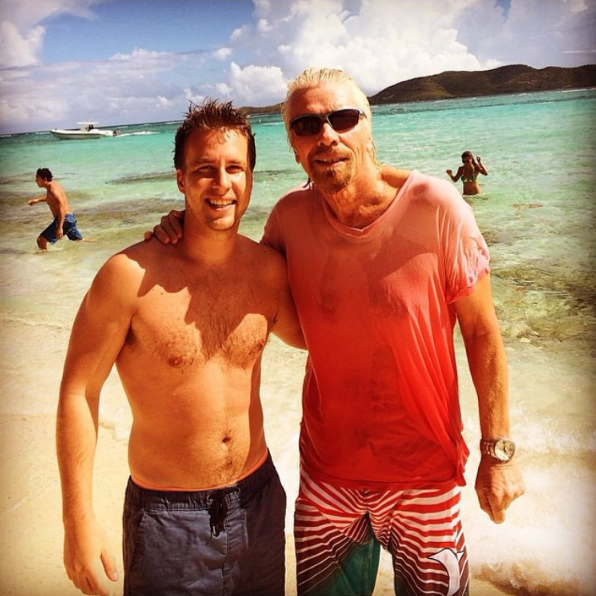Piloted by 43-year-old Peter Siebold and his 39-year-old co-pilot Michael Alsbury, the spaceplane took off under its WhiteKnightTwo carrier aircraft.
Just ten years earlier, in 2004, Sir Richard Branson founded Virgin Galactic with the vision of making space travel accessible to everyone. Owning 400 companies across the Virgin Group empire, Branson has been knighted at Buckingham Palace for ‘services to entrepreneurship’ and has an estimated net worth of $5 billion.
Today, he has a strong focus on philanthropy and space travel. Among Virgin Galactic’s ambitions are to establish the first hotel in space and to run a two-hour commercial flight from London to Sydney by travelling outside the Earth’s atmosphere.
At an altitude of 50,000 feet, SpaceShipTwo broke away from WhiteKnightTwo and fired its new engine as planned. Nine seconds after ignition, the tail booms of the spaceplane unexpectedly began to swing upwards, increasing the drag as it accelerated.
Two seconds later, SpaceShipTwo began to disintegrate mid-flight.
Peter Siebold was thrust from the craft, ejecting his parachute and returning to Earth with serious injuries. Co-pilot Michael Alsbury tragically lost his life in the crash.
The team of 400 Virgin Galactic staff watched on from the Space Port as they witnessed the shattering of a decade of hope, only to quickly learn that they had also lost the life of one of their close friends and colleagues, Michael Alsbury.
This was an incredibly sad day for Virgin Galactic. The team of scientists and engineers had worked tirelessly to test the boundaries of human possibility while doing everything in their power to ensure the safety of the brave test pilots.
The world’s media immediately turned its attention to Virgin Galactic and its founder, Sir Richard Branson. What had happened? Who was to blame? What would Branson do now?
On that day in October 2014, I was on my way to visit Branson on Necker Island. I was part of a small group of people invited to spend time on Necker with Richard. As we were flying in, he was of course now heading out to California to meet with the family of Michael Alsbury and his team of 400, to mourn with them and to work out what to do next.
Branson spent a day in California at the Mojave Space Port, taking the time to console everyone who was affected, to offer his counsel and to get a feel for the resolve of the team in the wake of such an accident. Upon his return to Necker Island the next day, I noticed he was visibly upset from the events of the previous two days. When we asked him why he came back to Necker to see us, he simply replied, ‘Because I said I would.’
To learn from one of the greatest business leaders of all time in the midst of the largest crisis of his career was eye-opening for me because it revealed so much of Branson’s humanity.
The next day, after sitting across from Branson over lunch as he and I discussed what’s wrong with traditional education and what needs to happen for it to improve, I decided to go for a walk along one of Necker’s many beautiful beaches. After a few hundred metres, I came to the tennis club nestled between the beach on one side and the lush green forest on the other. There, alone on a beanbag, Branson was sitting, still in his board shorts, deep in thought, peering out into space.
My time on Necker with Richard was an incredible experience but this moment was particularly profound for me. It caused me to stop in my tracks, in awe of the contrast presented by the image in front of me, this grand juxtaposition of Richard Branson the business icon and the reality of the person.
At this very moment, the world’s media was feverishly focused on this global icon and how the tragedy would impact on the ‘legend of Sir Richard Branson’, and all the while he was quietly sitting alone, in his board shorts, concerned and upset – just as you or I would be. It occurred to me how very human we all are regardless of our achievements.
It perfectly highlighted for me that history often puts people like Branson on a pedestal in a way that makes them ‘larger than life’ and diminishes their humanity.
The mythology that develops around them often disguises the lessons inherent in their stories by making their accomplishments appear unattainable, and their contribution unachievable. The reality is they are just people, with the same doubts and the same emotions as all of us. They are equally vulnerable and unsure of themselves as you and I are, and success and tragedy affect them much as they do us.
It was later found by the NTSB that there was no explosion, and the cause of the tail booms swinging up and ultimately destroying the spaceplane was human error. The team at Virgin Galactic have since put in place technological measures to ensure the human error cannot be repeated.
Through years of study, and precious moments like this time with Branson, I have learnt that the great figures throughout history all questioned their own resolve at times, wrestled with their self-belief and fought against feelings of inadequacy. The greats of this world are not superhuman icons who have reached an unattainable level of accomplishment – they too sit on beanbags in their board shorts by themselves and think and challenge and question.
I have discovered that these larger than life figures find their greatness not in being perfect but in realising they never will be. This gives them the resolve to move forward imperfectly. Their virtues were not effortlessly acquired or easily demonstrated but, like everyone else, gained through hard work and the endless struggle that comes with the search of one’s true self.

